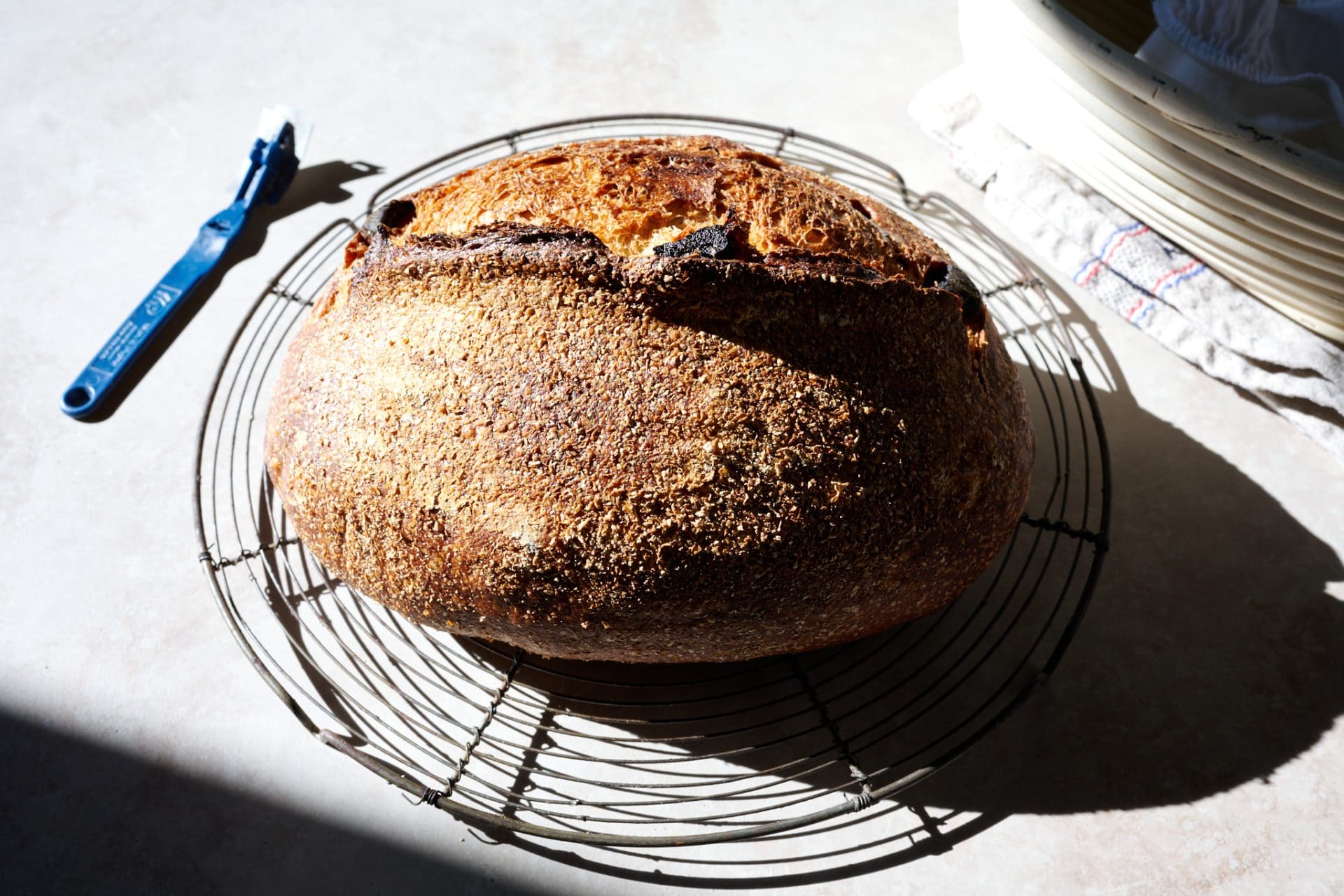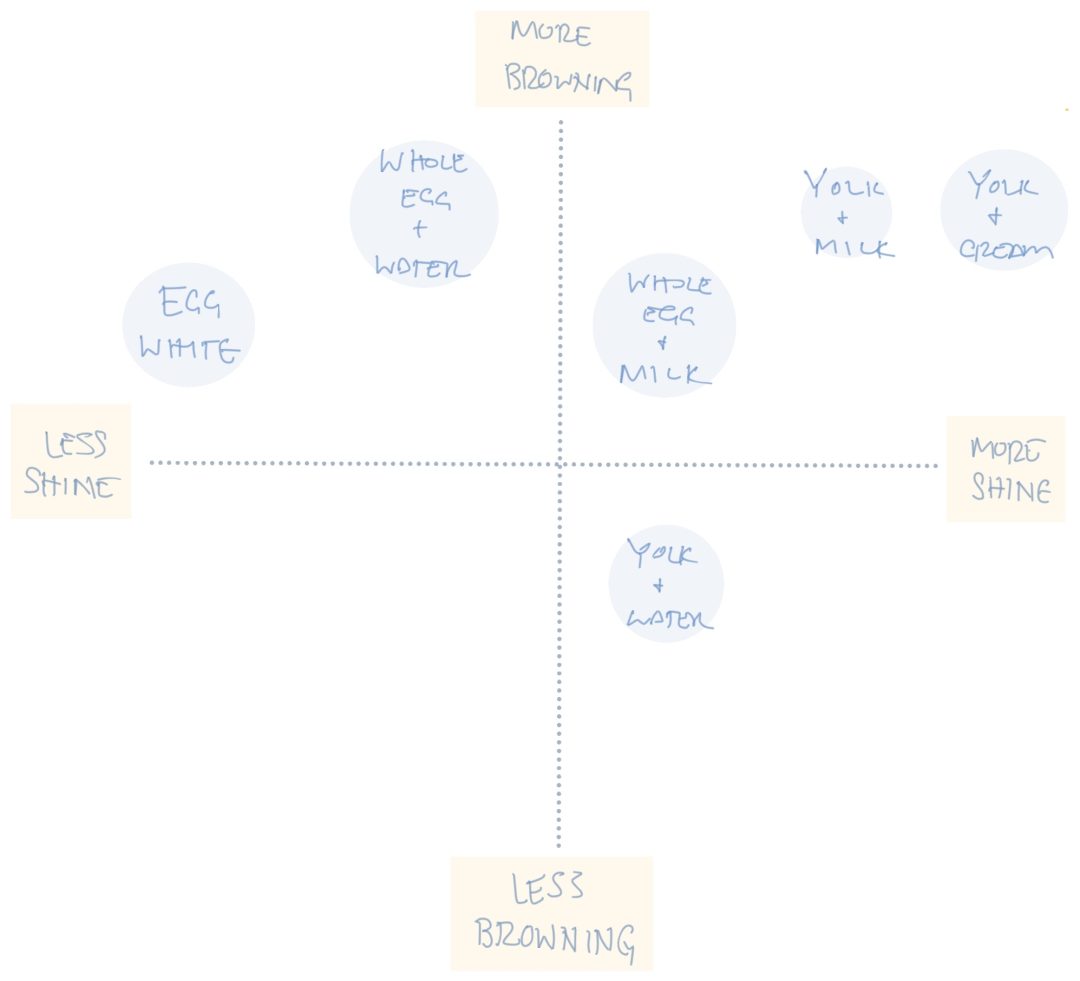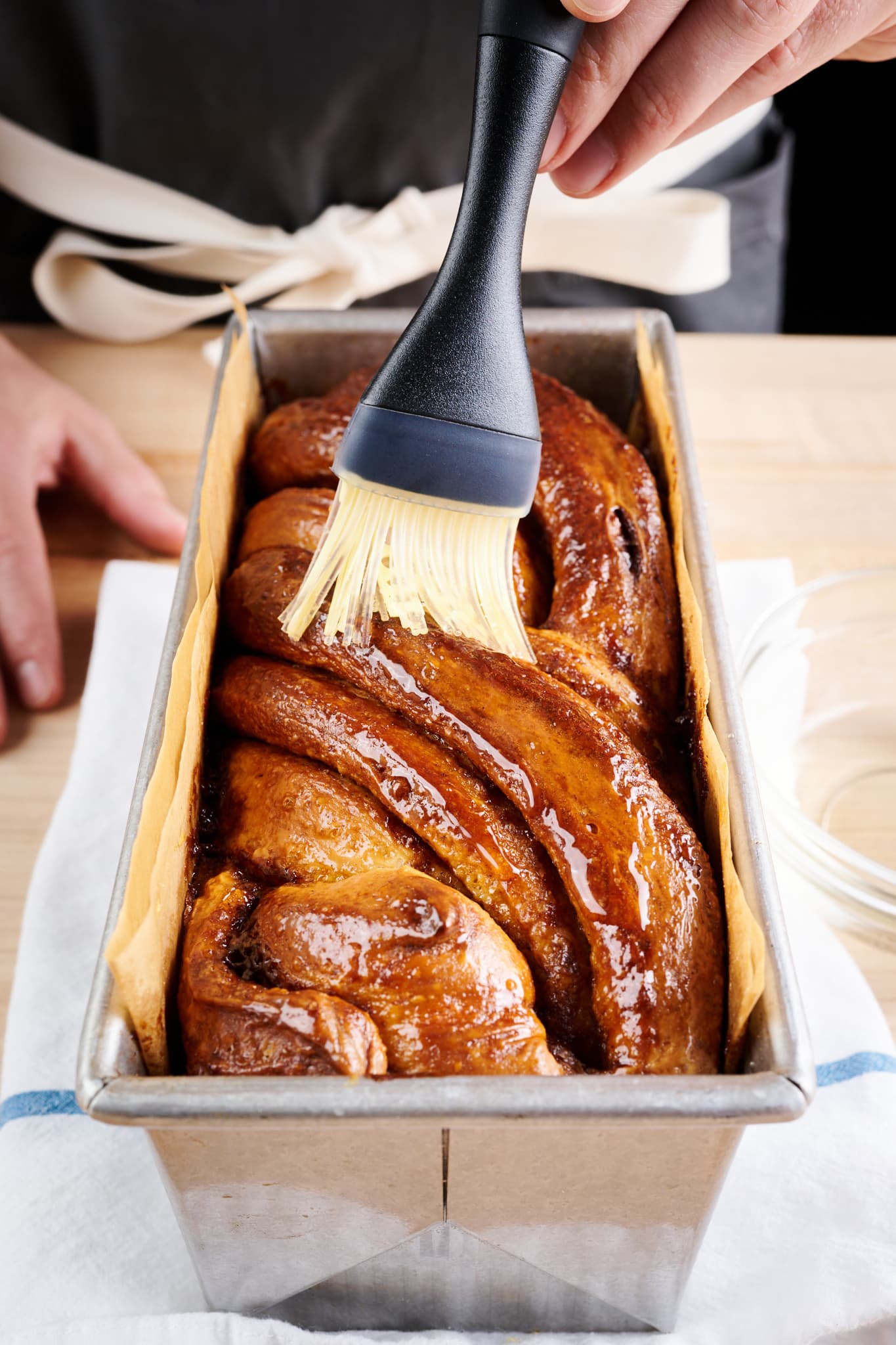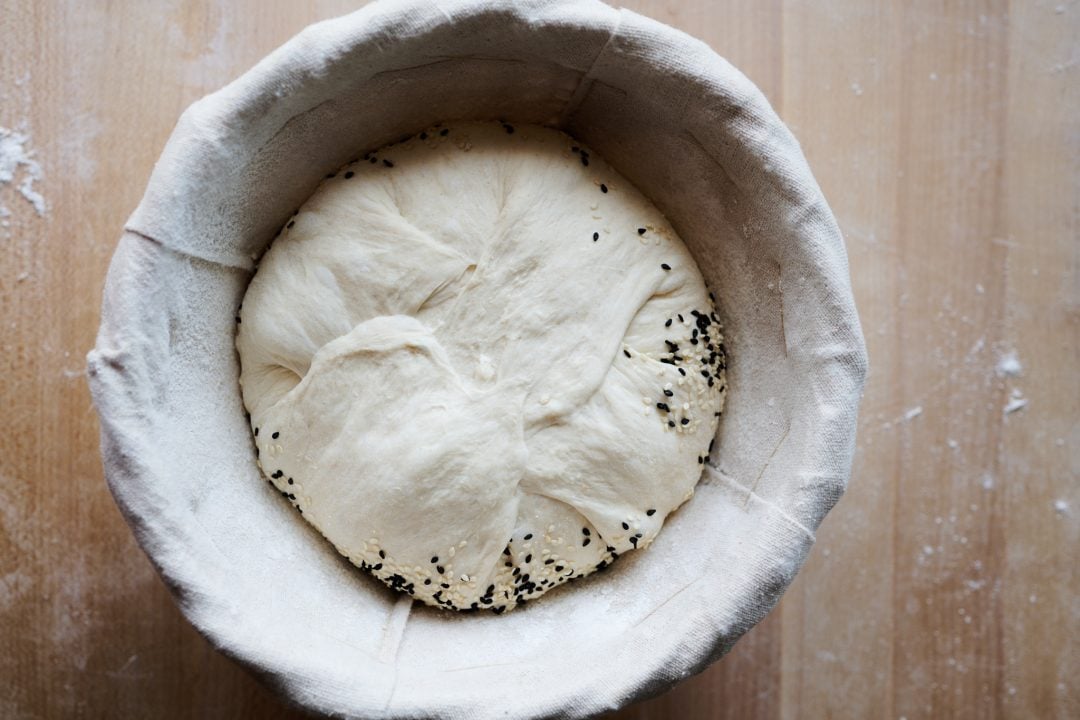Putting some sort of topping on your bread dough before you bake is a great way to add flavor, texture, nutrition, and visual appeal to almost any bread. The landscape of options is vast, and it’s also something you can experiment with on your own as you learn to personalize your bread baking. In this article, I talk through the two main methods on how to top bread dough–rolling the top in something like oats or brushing with a liquid such as an egg wash–as well as techniques for ensuring success.

Two Topping Styles
I see two different styles of toppings that are intended to enhance the surface of the bread dough:
- Adding seeds, grains, and/or cereals
- Using washes (like an egg wash)
The first are large, chunkier bits that are meant to stick to the dough and result in a rustic, highly textured crust. Such toppings are often seen on free-form (hearth style) loaves, pan loaves, or other specialty shapes (like my fougasse).
The second are liquids that are brushed on in order to make the finished crust take on a shiny appearance and to allow the baked good to rise without steaming the oven. There are several options in this category, each of which results in a particular finish: egg wash, milk wash, cream wash, melted butter, or raw flour. These toppings are more appropriate for buns, rolls, and pan loaves and are commonly used with dough that’s enriched with dairy, egg, or sugar (like my sourdough pumpkin dinner rolls).
Do you ever top bread dough after baking?
Not usually, but there are some applications where this might make sense. For instance, my sourdough babka calls for a simple sugar glaze after the babka is baked to give it a sweet, shiny crust. Some dinner-style rolls can benefit from a brush of melted butter while still warm from the oven to give them extra shine and savoriness. Of course, there’s also the cinnamon roll, which almost always benefits from icing or cream cheese frosting after baking.

Method 1 for topping bread dough: large toppings
Topping bread dough with larger toppings like seeds, cereals, and grains is an endless playground for exploration. And you can either use a single topping for a loaf of bread, or you can mix and match complementary ones to suit your bread recipe. For instance, using white sesame as you see above in my sunflower and sesame sourdough bread is visually striking, while pumpkin seed and sunflower seed have complementary flavors and taste delicious together.
Let’s take a look at some of my favorite toppings to use when baking loaves of bread, whether they are free-form or in a loaf pan, and then look at some practical steps on how to ensure they stick to your bread dough.
What ingredients work well to top bread dough?
Seeds like sesame, pumpkin, and flaxseed become aromatic and extra flavorful when they’re toasted as the bread bakes in the oven, much like when the seeds are toasted on a sheet pan before using in other applications. Oats become crisp and crunchy, providing flavor and added texture. Here is a list of some of my favorite toppings:
| Ingredient | Preparation (Style) |
| Oat | Raw (old-fashioned rolled or instant) |
| Sesame (white and black) | Raw |
| Pumpkin seed | Raw |
| Wheat germ (not to be confused with wheat bran, which may burn in the oven) | Raw (can be sifted freshly milled flour) |
| Sunflower seed | Raw |
| Quinoa | Raw |
| Benne seed | Raw |
| Flaxseed | Raw |
| Linseed | Raw |
| Salt (used primarily for buns and rolls) | Chunky sea salt (like Maldon) |
How to get toppings to stick to bread dough




First, I like to spread out the toppings in a thin layer on a quarter baking sheet placed next to my work surface. You could also use a clean kitchen towel or basket/bowl, and if you find yourself using the same toppings over and over, dedicating a round or oblong basket/banneton to hold the toppings can be convenient.
Then, there are two methods I use to ensure my toppings stick to my dough:
- Lay a moist towel on your work surface. Roll your dough on the moist towel to dampen the surface, and then roll the dough in the toppings.
- Use a handheld spray bottle to spritz the top of the dough after it’s shaped, and then roll it in the toppings.
To roll the dough in the toppings: Lay it down, seam side up, on the toppings, and rock it left and right (or around in a circle if shaping a boule) to ensure even coverage.
Finally, gently transfer the topped dough to your proofing basket, topping side down. Let’s look at a few videos on how to top bread dough, both a batard (oval) and boule (round) shape.
Video: How to top bread dough, boule (round shape)
How to score dough that’s been topped with large toppings

One challenge when topping bread dough, especially if the toppings are chunky and large (like pumpkin seeds or even rolled oats), is that the blade (or lame) used when scoring can snag, making it difficult to sufficiently cut into the dough. In such a case, I prefer to use scissors instead: you simply snip into the dough without having to worry about a sharp knife snagging on any large toppings.
Hold the scissors at a shallow angle and snip into the dough from one side to the other. Each cut starts where the last one left off, forming a zig-zag pattern across the top of the dough, allowing the loaf to rise and open in a controlled way during baking.
Method 2 for topping bread dough: washes, glazes, and flour
When baking rolls, pan loaves, or buns, a typical approach is to use an egg or dairy wash to encourage increased browning and give the top crust a shine. Additionally, rolls can be topped after baking with melted butter for shine and added richness. Finally, sweet products can call for a brush of simple sugar to give it a sweet crust with shine.
How do I make my bread shiny on top?
There are two typical approaches:
- Egg wash
- Simple syrup glaze
How to make and use an egg wash

An egg wash is a mixture of egg (either whole, just the yolk, or just the white) and liquid, usually milk or cream. Egg washes are a staple in baking and are often used when baking pastry, rolls, enriched pan loaves, or buns. Egg and dairy promote increased coloring through the Maillard reaction: the proteins in egg and dairy encourage browning, while the fat gives it shine.
To increase the shine, use a liquid with more fat (water will have the least shine; cream will have the most). To increase browning, use only the egg yolk in combination with cream.
Egg wash recipe
In a small bowl whisk together:
- One egg (either whole, just the yolk, or just the white)
- One tablespoon whole milk, cream, or water
Use a pastry brush to apply a light layer of the wash onto your dough just before baking. If your dough is to be scored (cut), it’s typically best to first brush on the wash, and then score the dough to avoid wash dripping into the cuts.
How to make and use a simple syrup glaze
You can use a simple syrup to give your baked goods shine and sweetness. Apply this glaze shortly after the item is removed from the oven.

The following recipe makes enough to fully glaze at least two of my sourdough babkas, which are baked in a 9 x 4 x 4-inch Pullman pan.
Simple syrup recipe
- 52g (¼ cup) granulated sugar
- 52g (¼ cup) water
In a small saucepan, combine the sugar and water. Heat, stirring occasionally, until the mixture bubbles and the sugar fully dissolves, 4 to 5 minutes. Transfer to a bowl and let cool completely. Use a pastry brush to apply the glaze after the baked good is removed from the oven and cooled slightly. The simple syrup will keep indefinitely in an airtight container in the refrigerator.
How to top bread dough with flour
You can dust the top of rolls or loaves (white or whole wheat) with white flour for a more rustic or “peasant” style appearance. Using flour is also a wonderful way to keep your bread (especially buns and rolls) vegan but still decorate the top.
The process couldn’t be simpler: before baking, use a fine-meshed sifter to dust the top of the dough lightly with white flour. I use all-purpose white flour for dusting.
Topping Bread Dough FAQs
Should I toast my seeds before using them as toppings?
Be sure to use raw seeds as a topping. Toasting seeds amplifies their flavor, but because the seeds will be on the exterior of your dough, they will toast as the loaf is baking in the oven. Toasting them before topping your dough will likely cause them to burn in the oven.
How do I make bread dough glossy or shiny on top?
To make your finished bread or pastry shiny, brush on an egg wash before baking or a simple syrup glaze after baking.
What vegan toppings can I use for bread?
Instead of using an egg wash, I like to use plain, raw, white flour for topping. This style of topping looks great on dinner rolls.
Do you brush the bread with butter before or after baking?
It’s best to brush on melted butter after your bread is baked in the oven, but while it is still warm and cooling on a wire rack.
Do I add salt to an egg wash?
It’s optional. If you add salt (usually a small pinch, about ⅛ teaspoon) before whisking, it will help thin the consistency of the wash, which can make it easier to brush on with a pastry brush.
What’s Next?
To try your hand at topping your bread dough, check out my sunflower and sesame sourdough recipe, oat porridge sourdough bread, or my green olive and herb sourdough recipe (which uses raw wheat bran as a topping).
After reading this how to top bread dough guide, visit my Baking Guides Page for more on all things bread baking.





